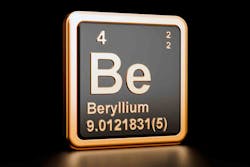OSHA Finalizes Standard for Processing, Handling Beryllium
The U.S. Dept. of Labor’s Occupational Safety and Health Administration published a final rule revising the beryllium standard for general industry. This final rule includes changes designed to clarify the standard, and simplify or improve compliance.
Beryllium is a lightweight metal noted for its exceptional stiffness. It’s used as specialty alloy (particularly with aluminum) to produce high-value investment castings, notably for aerospace and defense programs. It’s also used to produce beryllium-oxide ceramics. But, beryllium presents two risks of toxic exposure: first via soluble beryllium salts, which may occur via exposure to the elemental or refined forms of the metal; and second, via long-term exposure to beryllium oxide, usually by inhalation. In January 2017 OSHA issued a rule establishing new protections for workers who are exposed to beryllium in general industry, construction, and shipyards. That rule reduced the eight-hour permissible exposure limit from the previous level of 2.0 micrograms/m3 to 0.2 micrograms/m3. Above that level, employers must take steps to reduce the airborne concentration of beryllium. The rule requires additional protections, including personal protective equipment, medical exams, other medical surveillance and training. It also establishes a short-term exposure limit of 2.0 micrograms/m3 over a 15-min. sampling period.
According to OSHA, the final rule amends the following paragraphs of the beryllium standard for general industry: “Definitions,” “Methods of Compliance,” “Personal Protective Clothing and Equipment,” “Hygiene Areas and Practices,” “Housekeeping,” “Medical Surveillance,” “Hazard Communication” and “Recordkeeping.” It also has a new Appendix A: “Operations for Establishing Beryllium Work Areas.”
The compliance date for the final standard as modified is September 14, 2020. OSHA has been enforcing most of the provisions for general industry since Dec. 12, 2018. It began enforcing the provisions for change rooms and showers on March 11, 2019, and engineering controls on March 10, 2020.
The final standard will affect approximately 50,500 workers employed in general industry and is estimated to yield minor net-cost savings to employers.
The agency previously estimated that, once in full effect, its new Beryllium Standard will save 94 lives annually and prevent 46 new cases of beryllium-related disease. Workers in foundries, fabricating, machining and grinding operations where beryllium metal and alloys are processed; or those working with beryllium-oxide ceramics; and dental lab workers represent most of those at risk of exposure.
The agency estimated final standard will affect approximately 50,500 workers employed in general industry and would yield minor net-cost savings to employers.
